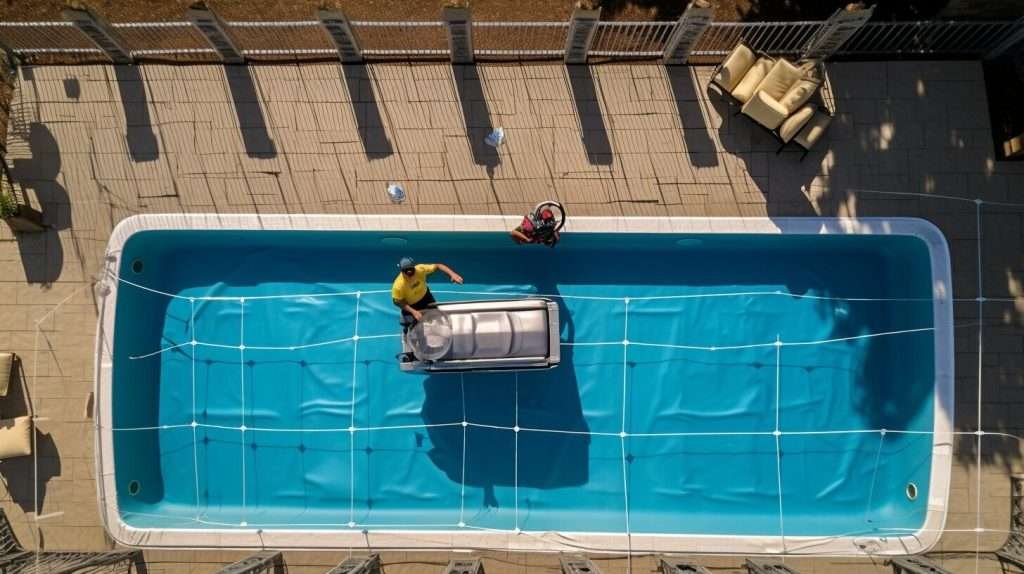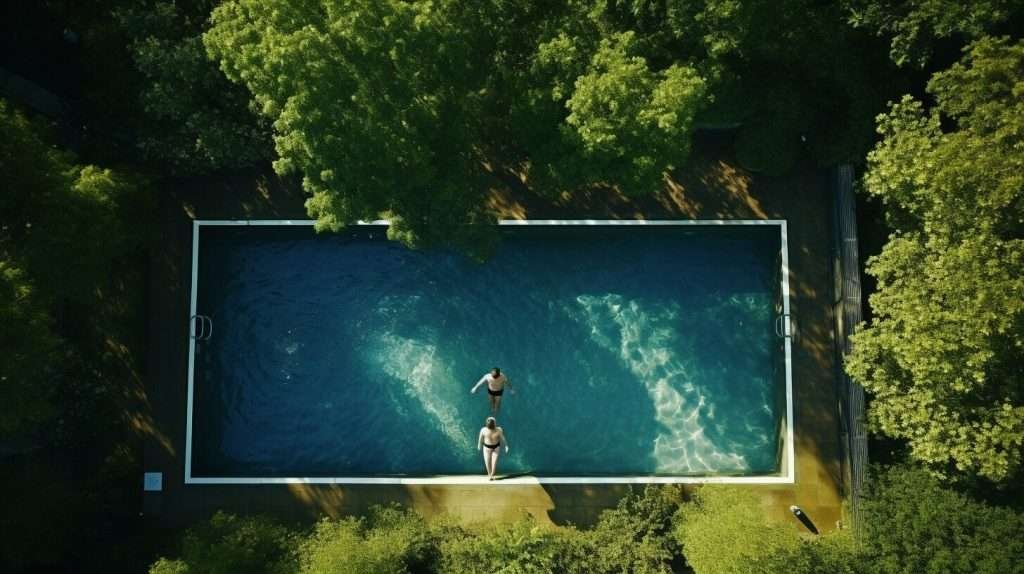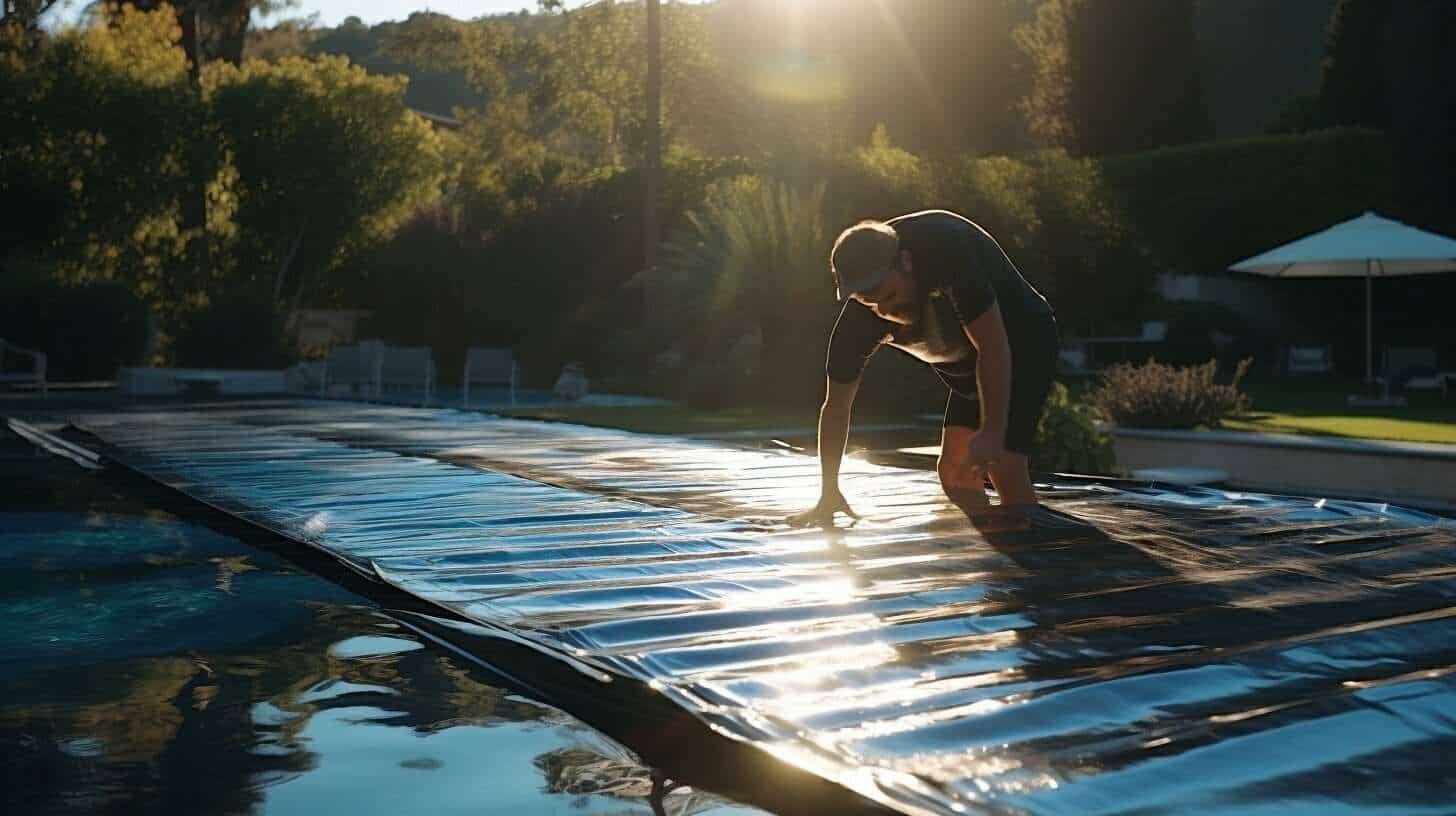As a professional copywriting journalist, I understand the importance of properly fitting a pool cover. Not only does it protect your pool from debris and maintain optimal chemical levels, but it also saves you time and money in the long run.
In this article, I will provide you with easy and effective steps for pool cover installation, as well as tips for proper sizing, maintenance, and troubleshooting. Whether you are a seasoned pool owner or a newcomer, this guide will ensure that you can easily and confidently fit your pool cover.
Key Takeaways:
- Fitting a pool cover is essential for protecting your pool and saving you time and money.
- Proper sizing, preparation, positioning, and securing are crucial steps in pool cover installation.
- Maintenance and care are necessary for ensuring the longevity of your pool cover.
- DIY pool cover fitting can be easy and effective with the right steps and tips.
Choosing the Right Pool Cover Size
When it comes to fitting a pool cover, selecting the right size is crucial. A cover that is too small will not adequately protect your pool, while a cover that is too large can be difficult to handle and may not effectively prevent debris from entering the water.
The most accurate way to determine the proper size for your pool cover is to measure your pool. Start by measuring the length and width of your pool at its widest points, and then add an additional 2-3 feet to each measurement to ensure adequate coverage. Round up to the nearest whole number when selecting a cover size.
| Pool Size | Recommended Cover Size |
|---|---|
| 12′ x 24′ | 16′ x 28′ |
| 16′ x 32′ | 20′ x 36′ |
| 20′ x 40′ | 24′ x 44′ |
It is important to note that covers with a larger size can be more difficult to manage during installation. If you are unsure about which size to choose, it may be helpful to consult a professional or refer to a pool cover size guide.

Pro Tip: Don’t forget to take into account any additional features, such as a diving board or ladder, that may affect the size of your pool cover.
Preparing Your Pool for Cover Installation
Before installing a pool cover, it’s important to take the necessary steps to prepare your pool. This will ensure that your cover is installed correctly and that your pool remains in good condition throughout its use. Below are the steps I take to prepare my pool for cover installation:
- Clean the pool: Start by cleaning the pool of any debris, such as leaves or dirt. Use a pool skimmer or net to remove any floating debris and vacuum the bottom of the pool to remove any settled debris.
- Check the chemical balance: Make sure the chemical levels in your pool are balanced before putting on a cover. This will ensure that your pool remains in good condition and that the cover does not become damaged by any chemicals.
- Remove any accessories: If your pool has any accessories, such as ladders or diving boards, remove them before installing the cover. This will ensure a proper fit of the cover and prevent any damage to the accessories.
By taking these steps, I can ensure that my pool is ready for cover installation. This ensures that my cover will fit properly and will protect my pool from debris and other elements. Keep in mind that regular maintenance and care of your pool cover is important to maintain its effectiveness. We’ll discuss this in more detail in the next section.

Positioning the Pool Cover
Now that your pool is clean and ready, it’s time to position the cover over the surface of the water. This can be a bit tricky, but with the right approach, it should be a breeze.
The first step is to find the center point of the pool and line it up with the center of the pool cover. Many pool covers will come with markings to help you with this process. If your cover doesn’t have markings, you can use a measuring tape to find the center point and mark it with a piece of tape or a chalk line.
Next, hold onto two opposite corners of the cover and carefully walk around the pool, allowing the cover to unfold and settle on the water’s surface. Alternatively, you can place the cover on a large flat surface nearby and then slowly drag it over the pool.
Once the cover is in position, use a broom or pool brush to smooth out any wrinkles or air pockets that may have formed underneath. This will help ensure that the cover is taut and properly aligned.

If you have a larger pool, it may be helpful to have a partner to assist you with positioning the cover. Make sure to communicate clearly and work together to ensure that the cover is properly positioned before moving on to the next step.
Securing the Pool Cover
Once the pool cover has been properly positioned over the water, it is important to secure it in place to prevent it from shifting or flying off during windy conditions. There are several methods for securing a pool cover, and the best approach will depend on the type of cover and the pool’s surroundings.
Anchor Method: This method is ideal for covers with anchor points around the perimeter. Simply attach the provided straps to the anchors and tighten them to ensure a snug fit.
| Anchor Method | Water Bag Method | Ratchet Strap Method |
|---|---|---|

| 
| 
|
Water Bag Method: For covers without anchor points, water bags can be used to weigh down the edges. Simply fill the bags with water and place them around the perimeter of the cover.
Ratchet Strap Method: Ratchet straps can be used for covers with grommet holes around the perimeter. Thread the strap through the grommets and tighten, ensuring the cover is taut.
No matter the method used, it is important to periodically check the cover and adjust the securing devices as needed. A loose cover can allow debris to enter the pool and reduce its effectiveness.
Dealing with Obstacles and Accessories
When fitting your pool cover, it’s important to take into account any obstacles or accessories that may be present. These can include ladders, diving boards, slides, or even decorative rocks and statues. Failure to properly navigate around these objects can result in an improperly fitted cover, leaving your pool susceptible to debris and dirt.
The first step in dealing with obstacles is to remove any removable attachments, such as ladders or slides. If an attachment cannot be removed, carefully measure around it to ensure that the cover will fit properly with the attachment in place.
In addition to obstacles, it’s important to consider any unique features of your pool. For example, if your pool has an irregular shape or size, you may need to purchase a custom cover or make adjustments to a standard cover to ensure a proper fit.
In some cases, you may need to make modifications to your pool or its surroundings to allow for proper cover fitting. This could include trimming back overhanging branches or removing nearby landscaping features that could interfere with the cover’s placement.
Remember, taking the time to properly deal with obstacles and accessories can mean the difference between a functioning cover and a cover that leaves your pool vulnerable to dirt and debris. Take the necessary steps to ensure a proper fit and maximum protection for your pool.

Regular Maintenance and Care
Proper maintenance and care of your pool cover is crucial for ensuring long-lasting protection for your pool. Here are some key tips to keep in mind:
- Regular cleaning: Be sure to regularly remove any debris or standing water from the top of the cover. Use a pool cover pump to remove excess water and a soft-bristled brush to remove debris that may be stuck to the surface. For tougher stains, use a mild detergent and rinse thoroughly with clean water.
- Chemical balance: Keep the chemical balance of your pool water in check to prevent damage to the cover. The pH levels should be between 7.2 and 7.8, while total alkalinity should be between 80 and 120 parts per million (ppm). Consult with a pool professional for specific guidelines based on your pool’s size and other factors.
- Inspection: Regularly inspect your pool cover for any signs of damage, such as rips, tears, or holes. Any damage should be repaired immediately to prevent further deterioration and ensure proper coverage of your pool.
By following these maintenance and care tips, you can ensure that your pool cover remains in top condition and provides maximum protection for your pool.

DIY Pool Cover Fitting Tips
If you’re a DIY enthusiast, fitting a pool cover is not a daunting task. However, you need to follow certain guidelines to ensure that the pool cover fits perfectly and securely. Here are some tips that will guide you through the process: First, measure your pool carefully to ensure that you purchase a cover of the right size. It’s also important to choose a high-quality cover that can withstand the elements and provide proper insulation. Once the cover is installed, make sure to regularly clean it and inspect for any damage. Additionally, following pool cover maintenance tips will help prolong its lifespan and keep your pool clean and safe for swimming.
- Measure your pool: To get the right size of the pool cover, you need to measure your pool carefully. Measure the length and width of the pool, and add an extra foot to each measurement to accommodate the overlap of the cover on the sides.
- Smooth out wrinkles: Before laying out the cover, you need to smooth out any wrinkles and folds. This ensures that the cover fits snugly over the water and eliminates any unwanted folds.
- Use a pool cover reel: A pool cover reel makes it easier to cover and uncover your pool. It also protects the cover from premature wear and tear by preventing it from dragging on the ground. Installing a pool cover reel is a simple process that you can do on your own.
- Check the pool cover regularly: Once you’ve installed the pool cover, it’s important to check it regularly for any signs of wear and tear. Look for any holes, tears or rips. Repair them promptly to prevent them from becoming bigger problems.
- Store the pool cover carefully: During the off-season, make sure you clean the pool cover thoroughly and store it in a dry, cool place. You can fold the cover neatly and place it in a storage bag to protect it from the elements.
By following these simple tips, you can fit your pool cover like a pro and ensure that your pool is protected from leaves, debris, and other unwanted elements.

Conclusion
Now that you know how to fit a pool cover, you can ensure that your pool stays clean and safe year-round. Remember to choose the right size for your pool, prepare your pool properly, position the cover correctly, secure it firmly, and regularly maintain it to ensure it lasts for many seasons to come.
By following the easy and effective steps outlined in this article, you can install a pool cover yourself and save money in the process. If you have any questions or run into any issues, don’t hesitate to seek professional assistance.
Thank you for reading and happy swimming!
Are the steps for fitting a pool cover the same for installing your own pool cover?
The steps for fitting a pool cover may differ from installing your own pool cover. Fitting a pool cover typically involves measuring the dimensions of the pool, ensuring the cover aligns properly, and securing it tightly. However, installing your own pool cover encompasses additional tasks like purchasing a cover, choosing the right type for your pool, and following manufacturer instructions accurately.
FAQ
Q: How do I fit a pool cover?
A: Fitting a pool cover is easy and effective when you follow these steps:
Q: How do I choose the right pool cover size?
A: To determine the proper fit for your pool, consider the size and shape of your pool and follow our pool cover size guide.
Q: What steps should I take to prepare my pool for cover installation?
A: Before installing a pool cover, make sure to clean your pool, balance the chemicals, and remove any debris to ensure a proper installation.
Q: How do I position the pool cover over the water?
A: Positioning the pool cover requires careful alignment and coverage over the surface of the water. Follow our steps to ensure a proper fit.
Q: How do I secure the pool cover in place?
A: There are various methods for securing a pool cover, including using anchors, water bags, or ratchet straps. Choose the method that works best for you.
Q: What should I do about obstacles or accessories that may interfere with the pool cover fitting?
A: If you have any obstacles or accessories, such as ladders or diving boards, they can be easily handled by adjusting the pool cover to accommodate them.
Q: How do I maintain and care for my pool cover?
A: Regular maintenance and care are essential for prolonging the life of your pool cover. Clean it, remove debris, and inspect for any damage regularly.
Q: Do you have any DIY pool cover fitting tips?
A: If you prefer to fit your pool cover yourself, we have additional tips and advice, including troubleshooting common issues and ensuring a proper fit.


